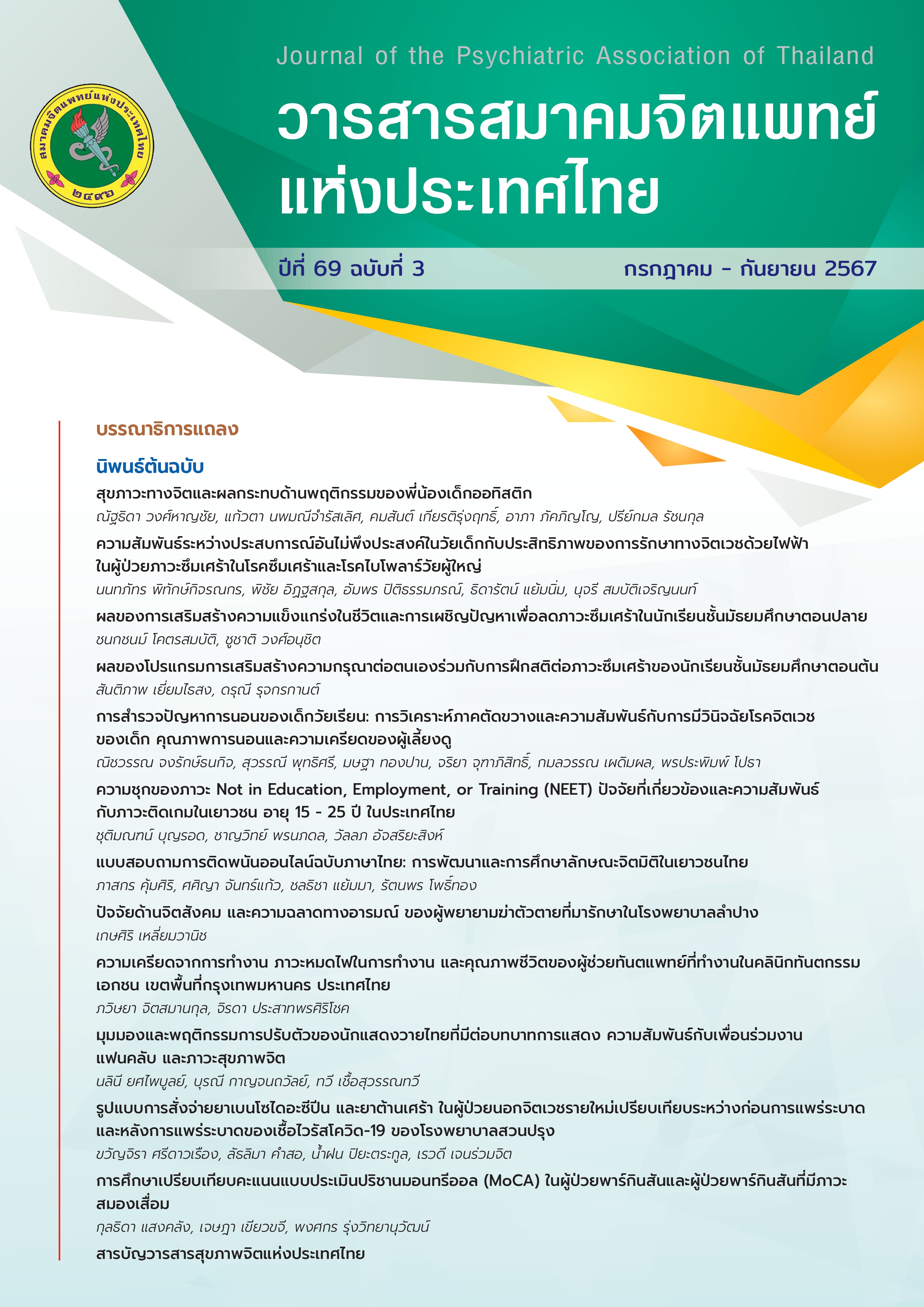Work Stress, Occupational Burnout and Quality of Life among Dental Assistants in Private Dental Clinics, Bangkok, Thailand
Main Article Content
Abstract
Objective: This study aimed to investigate the prevalence and factors associated with work-related stress, burnout, and quality of life among dental assistants working in private dental clinics in Bangkok.
Methods: This cross-sectional study used an online survey to collect data from 370 dental assistants in Bangkok. Self-administered questionnaires consisting of a personal information survey, the Suanprung Stress Test (SPST-20), the Maslach Burnout Inventory-General Survey (MBI-GS), and the World Health Organization Quality of Life-BREF Thai version (WHOQOL-BREF-THAI) were employed as the research instruments. Data were analyzed using multiple linear regression, stepwise method with a significance level of 0.05.
Results: Majority of dental assistant samples experienced moderate stress levels (41.3%), reported good quality of life (66.2%), and showed no signs of burnout (96.8%). Linear regression analysis revealed a positive correlation between increased working hours and stress (B=4.531, p=0.009) as well as quality of life (B=8.298, p<0.001). Conversely, increased work experience showed a negative correlation with both stress (B=-9.945, p=0.012) and quality of life (B=-10.758, p=0.006)
Conclusion: Most dental assistants had moderate stress levels and no burnout, with a good quality of life, Nevertheless, it remains crucial to emphasize appropriate working hours and provide support for other welfare measures to prevent high levels of stress and improve the quality of life for dental assistants.
Article Details

This work is licensed under a Creative Commons Attribution-NonCommercial-NoDerivatives 4.0 International License.
Articles submitted for consideration must not have been previously published or accepted for publication in any other journal, and must not be under review by any other journal.
References
Dental Council. Dental Council Statistics [Internet]. Bangkok: 2024 [cited 2024 Jul 4]. Available from: https://dentalcouncil.or.th/Pages/Stat
Bangkokbiznews. The Social Security Office clarifies that dental benefits are not inferior to those provided by other public health funds [Internet]. Bangkok: Bangkokbiznews; 2024 [cited 2024 Feb16]. Available from: https://www.bangkokbiznews.com/health/well-being/1111970
Locker D. Work stress, Job satisfaction and emotional well-being among Canadian dental assistants. Community Dent Oral Epidemiol 1996; 24(a): 133-7
Locker D, David B, Dan O. Work-related stress and its predictors among Canadian dental assistants. Community Dent Oral Epidemiol 1989; 17(S): 263-6
Uzil N, Meyerson J, Birenzweig Y, Elil L. Professional burnout and work stress among Israeli dental assistants. Psychol Health Med 2019; 24(1): 59-67.
Chen-Yi L, Ju-Hui W, Je-Kang D. Work stress and occupational burnout among dental staff in medical center. J Dent Sci. 2019; 14(3): 295–301.
Ronald O, Ruth F. Burnout and engagement in relation with job demands and resources among dental staff in Northern Ireland. Community Dent Oral Epidemiol 2011; 39(1): 87–95.
Gómez-Polo C, Casado AMM, Montero J. Burnout syndrome in dentists: Work-related factors, J Dent 2022; 121:104143
Eun-Jung K, Young-A J, Seung-Ho B, Yoo Sang B. High level of burnout and depression in a population of senior dental student in school of dentistry in Korea. J Dent Sci 2021; 16(1): 65-70.
Bercasio LV, Rowe DJ, Yansane AI. Factors associated with burnout among dental hygienists in California. J Dent Hyg 2020; 94(6): 40-8.
Phichitdecha N, Thamdee P. The work context in dental business and the health of private dentists. Journal of Social Sciences and Humanities. 2016; 42(2): 170-88.
Thammasiri P. Burnout in dental assistants in Songkhla Province. Journal of Dental Public Health 2021; 26: 24-36.
Jongkolsatit V. Stress among dental students at a private university. Journal of Suddhiparitad 2021; 35(4): 104-24.
Yamane T. Statistics: An introductory analysis. New York, NY: Harper & Row; 1973.
Mahatnirunkul S, Pumpaisanchai W, Tapanya, P. Development of the Suanprung stress test measurement model. Suanprung Journal 1997; 13: 1-20.
Kleepbua C, Suttiwan P. Development of a causal model of job burnout: Application of the job demands-resource model. [Master’s thesis]. Chulalongkorn University, Faculty of Psychology Department of Industry Psychology; 2009
Mahatnirunkul S, Tuntipivatanaskul W, Pum-posanchai W. Comparison of the WHOQOL-100 and the WHOQOL-BREF (26 items). J Ment Health Thai 1998; 5: 4-15
Yu H, Zhang Y, Panqi X, Xinglin F, Lifang Z, Fang W, Xiaoming L, Hua Z. The influence of long working hours, occupational stress, and well-being on depression among couriers in Zhejiang, China Front Psychol 2022; 13: 928928.
Wong K, Chan AHS, Ngan SC. The effect of long working hours and overtime on occupational health: a meta-analysis of evidence from 1998 to 2018. Int J Environ Res Public Health 2019; 16(12): 2102.
Ochiai Y, Takahashi M, Matsuo T, et al. Characteristics of long working hours and subsequent psychological and physical responses: JNIOSH cohort study. Occup Environ Med 2023; 80:304-11.
Humpel N, Caputi P. Exploring the relationship between work stress, years of experience and emotional competency using a sample of Australian mental health nurses. J Psychiatr Ment Health Nurs 2001; 8(5):399-403.
von Bonsdorff MB, Strandberg A, von Bonsdorff M, Törmäkangas T, Pitkälä KH, Strandberg TE. Working hours and sleep duration in midlife as determinants of health-related quality of life among older businessmen. Age Ageing 2017;46(1):108-12.
Woo D, Lee Y, Park S. Associations among working hours, sleep duration, self-rated health, and health-related quality of life in Korean men. Health Qual Life Outcomes 2020;18(1):287.
Gkorezis P, Erdogan B, Xanthopoulou D, Bellou V. Implications of perceived overqualification for employee's close social ties: The moderating role of external organizational prestige. J Vocat Behav 2019; 115: 103335.
Gupta S, Garg M, Ahuja K. Quality of life as predicted by job satisfaction among employees. Indian Journal of Mental Health 2022; 9(1): 53-7.
Powdthavee N, Lekfuangfu WN, Wooden M. What's the good of education on our overall quality of life? A simultaneous equation model of education and life satisfaction for Australia. J Behav Exp Econ 2015; 54:10-21.


